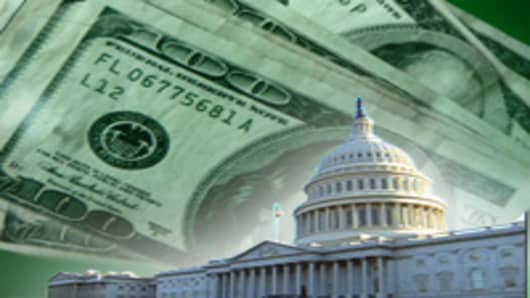The US government’s latest effort to prop up financial institutions and defrost global credit markets takes a big step in the right direction, but it also leaves a number of questions unanswered, suggesting policymakers may still not be ahead of the curve, analysts say.
"This is second or third variation of what [Treasury Secretary Henry] Paulson's expected he'd have to do," says William Niskanan, chairman emeritus of the Cato Institute and a former White House economist, addressing what some consdiered a major policy reversal.
- How the Revised Plan Will Work
The three-part plan outlined Tuesday, mirrored by Washington’s G7 partners, calls for a recapitalization of banks, a guarantee on inter-bank lending and FDIC insurance on non-interesting bearing bank accounts.
“I wish we had taken today's steps three weeks ago,” says former FDIC Chairman William Isaac.
The $250 billion recapitalization plan, in which the government injects capital in exchange for an equity stake, is drawing the most attention, partly because it follows similar moves by European governments.
"This was done by Treasury sooner than it wanted to," says Harvard University's Robert Glauber, who as a top Treasury official helped oversee the government's savings and loan rescue plan almost two decades ago.
Glauber says unlike previous measures aimed at liquidity, the currenct batch address confidence and solvency.
"This is certainly an admission that the TARP [auction] was taking too long," says Robert Brusca, chief economist at FAO Economics, referring to the controversial Treasury-Federal Reserve plan of three weeks ago, which creates a government auction to purchase bad debts from financial institutions.
Regardless of the timing, others say the government needs to commit more money than presently earmarked.
“I was a little disappointed with the $250 billion number,” adds Isaac. “It wouldn't surprise me if there is a need for more. I don’t why they couldn’t have said we're prepared to put in what it takes."
Under the plan, half of the $250 billion will go to nine big institutions (click here for list), with the rest available for the other 8,400 banks, savings and loans and credit unions in the country. Thus far, the government has only authorized $350 million of the $700 million Paulson requested three weeks ago.
Though there’s a general perception that the recapitalization has a better and faster chance of working than the auction model, skepticism remains about its effectiveness.
“How many banks are going to take a look at this and say thanks but no thanks,” says independent bank analysts Bert Ely. “I think its a major mistake to twist the arms of these banks.”
Though the government does not get voting rights with its equity stakes under the plan, it does require participating banks to agree to restrictions on executive compensation, including a ban on so-called golden parachutes, or exit packages, as well as corporate governance rules..
Isaac says the banks have incentive enough in the current economic environment.
“I can see some banks coming in” he says. "Banks don't have a lot of room to grow,” so they need new capital to borrow. In essence, every dollar in cash injection, gives them another ten in leverage.
Even if the recap plan enjoys only modest success, it still throws doubt on the future of the auction plan, which was never wildly.
Some analysts say the government will stick with the fairly unpopular plan, using it sparingly, if only for face-saving reasons. Others say though the auction's value has been diminished, it has some utility.
"They need to get bad loans off the balance sheet," says Glauber
“It could provide an alternative to mark-to-market [accounting],” says Brusca. “If it helps with price discovery it could become very useful in helping banks reprice their troubled securities.”
Isaac, who adamantly opposes the auction process, says if all the budgeted funds don’t go to a recap, some of the money could be used for an economic stimulus package or put to “good use” guaranteeing inter-bank debt.
The government lending guarantee measure outlined Tuesday has been sought by many. By reducing, if nor eliminating, risk, it encourages banks to lend money among themselves. That would lower global lending rates, as manifested in Libor, and supposedly start a chain reaction of lending, trickling down to the rest of the economy.
The interbank plan “appears to be the one possible aspect of all this," says Ely.
But not without risk, says Glauber. "By guaranteeing all the debt, you make it possible for the weak [banks] to borrow a lot of money to try to make themselves whole," doing even more damaage to their balance sheets, what he calls "the S&L problem."
Skeptics say even if that works, it does not mean banks will want to lend to consumers and businesses, which is often the case during recessions.
“Right now all this propping up is to solve the confidence problem,” says Brusca. “You still haven't fixed the mortgage market, which is a cesspool of securities values.” He says if that’s not fixed – and that’s another rescue plan or group of measures-- then lenders capital wins up getting hurt again.
In sum, the latest measures—along with the spate of previous ones—might be considered the beginning of the solution.
Much remains to be seen about their implementation and to what extent theory meets reality, particularly because it is sometimes difficult to separate this one-of-a-kind financial crisis and the conventional cyclical economic downturn.
"I think the Treasury is asking for almost a blank check because they don't what what's going to work," says Niskanen.




